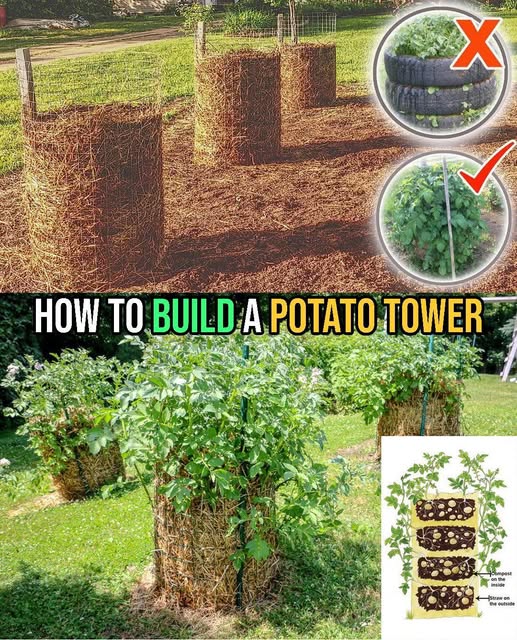Short on space but dreaming of a hearty potato harvest? A potato tower might be exactly what your garden needs. Ideal for small yards, balconies, or urban patios, this space-saving method lets you grow a generous crop using vertical height—not horizontal space. Even better? Using straw as a key building material improves aeration and drainage, helping your potatoes thrive.
Here’s your step-by-step guide to building a productive potato tower at home.

🌟 Why Choose a Potato Tower?
- ✅ Space-Efficient: Perfect for tiny gardens or even balconies.
- ✅ Easy Harvest: No digging—just pull apart the tower.
- ✅ Better Drainage & Airflow: Healthier roots and fewer rot issues.
- ✅ Lower Pest Risk: Reduced contact with ground-level soil and bugs.
🧰 Materials You’ll Need
- Wire fencing or a sturdy mesh (for the tower frame)
- Straw (preferably clean and weed-free)
- Good-quality compost and soil
- Certified seed potatoes
- Gardening gloves
- Watering can or hose
📍 Step-by-Step Guide to Building Your Potato Tower
1. Pick a Sunny Spot
Choose a location that gets at least 6 hours of sunlight a day. Potatoes love the sun!
2. Build the Tower Frame
- Cut your wire fencing or mesh to about 2–3 feet in diameter and 3–4 feet tall.
- Shape it into a sturdy cylinder and secure the ends together.
- Optional: Place it on a wooden pallet or platform with wheels if you want mobility.
3. Create a Healthy Base
- Add a thick layer of straw at the bottom for drainage.
- Add 6 inches of soil-compost mix on top of the straw.
4. Plant the First Layer
- Place seed potatoes (eyes facing up) on the soil layer, spacing them about 6 inches apart.
- Cover them with more soil-compost mix.
- Add another layer of straw around the inside edge to support the structure.
5. Layer as They Grow
- As the potato plants grow, keep adding straw around the sides and more soil inside, always leaving a few inches of the plant above soil level.
- This encourages more potatoes to form along the buried stems.
6. Watering and Care
- Keep the soil consistently moist, but never soggy.
- Water slowly to ensure deep moisture without waterlogging.
🥔 Harvest Time
Once the foliage turns yellow and begins to die back, your potatoes are ready!
- Simply remove the top layers of straw and soil by hand.
- Gently dig out your homegrown potatoes—no tools needed.
🌿 Bonus Tips for Success
- 🥔 Use Certified Seed Potatoes: They’re disease-resistant and more productive.
- 🐛 Check for Pests: Inspect regularly for insects or signs of rot.
- 🌞 Rotate Sunlight: If your tower is on wheels, turn it every few days for even sun exposure.
🌱 Why You’ll Love It
Potato towers aren’t just practical—they’re fun. Watching your plants grow skyward and harvesting from the top down is rewarding and educational. It’s also a great way to get kids involved in gardening, even if you only have a small patch of yard or a city balcony.
So roll up your sleeves and start stacking! Your delicious, homegrown potatoes await.
Inspired by this method? Share it with your friends and fellow gardeners! 🧤🌻





